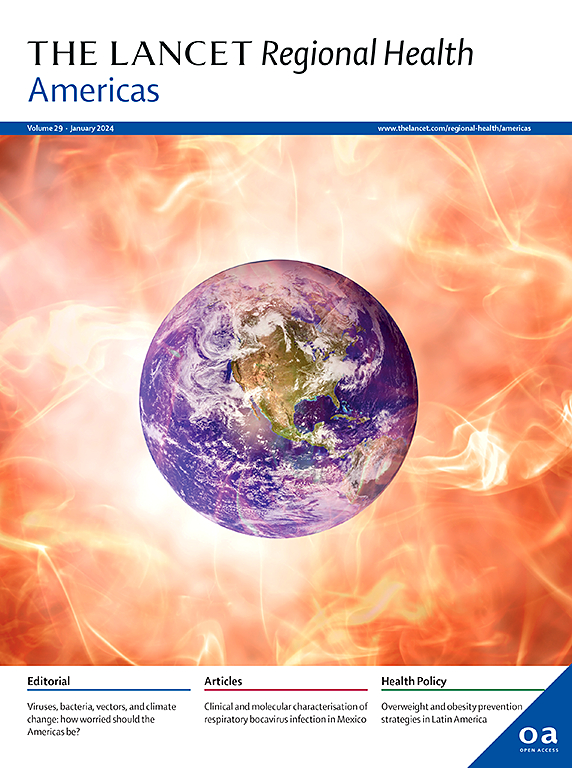Estimating the effects of temperature on mortality and hospitalisations under RCP2.6 and RCP8.5 scenarios in the short- and long-term by region in Chile: a population-based, modelling study
IF 7
Q1 HEALTH CARE SCIENCES & SERVICES
引用次数: 0
Abstract
Background
In a warming world, it is generally accepted that increasing temperatures affect human health. In many regions of the world, however, these effects are poorly understood. To address this issue in Chile, we estimated the potential change in all-cause and cardiovascular and temperature-related (CVT) mortality and hospitalisations associated with four different climate scenarios by region.
Methods
Using Chilean health data and ERA5 reanalysis data, we modelled the relationship between historical health outcomes and monthly temperature indices using Generalised Additive Models. After evaluating the models' predictive performance, we used them to estimate changes in health outcomes associated with bias-adjusted climate projections representing four scenarios: short-term (2031–2060) and long-term (2061–2090) periods under both Representative Concentration Pathways (RCPs) 2.6 and 8.5.
Findings
Scenario-based health outcomes show clear north-south variations. Compared to historical levels, all-cause mortality increases by ∼1.5% in northern regions but decreases by ∼1% in southern regions across scenarios. CVT mortality decreases (0.2–3.6%), especially in the south; however, Arica and Tarapacá in the north show sharp increases (up to 30%) under warmer scenarios. Conversely, all-cause and CVT hospitalisations increase in northern/central regions (higher in summer, lower in winter), while southern/austral regions show slight decreases (∼1%).
Interpretation
These findings highlight the need for region-specific analyses and public health strategies in Chile. Northern regions might require plans that reduce the risk of heat-related mortality and morbidity, while southern regions might adjust healthcare services because of potential shifts in healthcare needs.
Funding
National Agency for Research and Development, Chile and University College London, UK.
估计智利按地区在RCP2.6和RCP8.5情景下短期和长期温度对死亡率和住院率的影响:一项基于人口的模拟研究
在一个不断变暖的世界里,人们普遍认为气温升高会影响人类健康。然而,在世界许多地区,人们对这些影响知之甚少。为了解决智利的这一问题,我们按地区估计了四种不同气候情景下全因和心血管及温度相关(CVT)死亡率和住院率的潜在变化。方法利用智利健康数据和ERA5再分析数据,采用广义加性模型对历史健康结果与月温度指数之间的关系进行建模。在评估了模型的预测性能后,我们使用它们来估计与偏差调整后的气候预测相关的健康结果变化,这些气候预测代表四种情景:短期(2031-2060)和长期(2061-2090)时期,代表浓度路径(rcp) 2.6和8.5。基于情景的健康结果显示出明显的南北差异。与历史水平相比,在不同情景下,北部地区的全因死亡率增加了约1.5%,但南部地区的全因死亡率下降了约1%。CVT死亡率下降(0.2-3.6%),特别是在南方;然而,在较暖的情景下,非洲和塔拉帕ac在北方显示出急剧增加(高达30%)。相反,全因和CVT住院率在北部/中部地区增加(夏季较高,冬季较低),而南部/南部地区略有下降(约1%)。这些发现强调了在智利进行区域特定分析和公共卫生战略的必要性。北方地区可能需要制定计划,以降低与热有关的死亡率和发病率的风险,而南方地区可能会因为医疗需求的潜在变化而调整医疗服务。资助:智利国家研究与发展署和英国伦敦大学学院。
本文章由计算机程序翻译,如有差异,请以英文原文为准。
求助全文
约1分钟内获得全文
求助全文
来源期刊

Lancet Regional Health-Americas
Multiple-
CiteScore
8.00
自引率
0.00%
发文量
0
期刊介绍:
The Lancet Regional Health – Americas, an open-access journal, contributes to The Lancet's global initiative by focusing on health-care quality and access in the Americas. It aims to advance clinical practice and health policy in the region, promoting better health outcomes. The journal publishes high-quality original research advocating change or shedding light on clinical practice and health policy. It welcomes submissions on various regional health topics, including infectious diseases, non-communicable diseases, child and adolescent health, maternal and reproductive health, emergency care, health policy, and health equity.
 求助内容:
求助内容: 应助结果提醒方式:
应助结果提醒方式:


